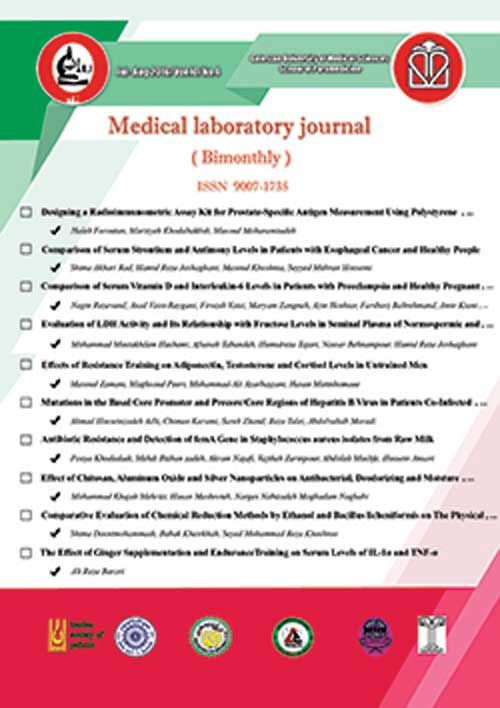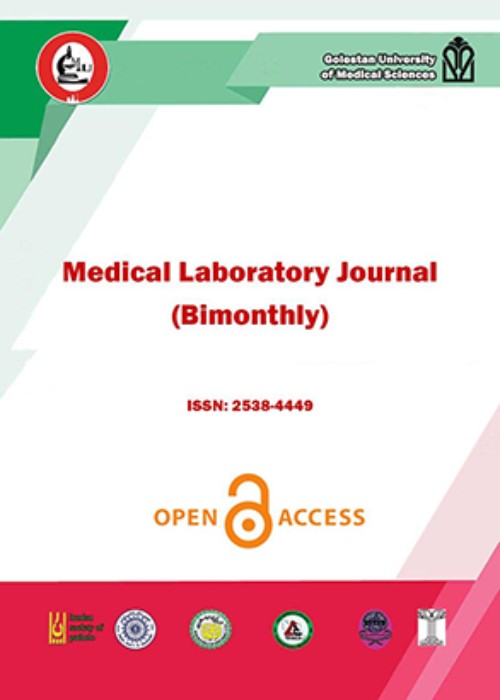فهرست مطالب

Medical Laboratory Journal
Volume:11 Issue: 4, Jul-Aug 2017
- تاریخ انتشار: 1396/06/15
- تعداد عناوین: 8
-
-
Pages 1-8Obesity is a health problem defined as abnormal or excessive fat accumulation in adipose tissue. Adipokines such as adiponectin, visfatin and resistin are bioactive polypeptides with pro- and anti-inflammatory properties that are secreted by the adipose tissue that are involved in the pathogenesis and prognosis of diseases such as type 2 diabetes, metabolic syndrome and cancer. This survey aimed to review the role of these hormones in the pathogenesis and prognosis of breast cancer in obese postmenopausal women. In obese individuals, increased level of leptin leads to tumorigenesis and progression of breast cancer though JAK/STAT3 pathway. These individuals have decreased level of adiponectin, which has a protective effect against carcinogenesis via AMPK pathway. Obese individuals also have increased level of visfatin, which induces the secretion of proinflammatory cytokines such as TNFα and triggers growth of cancer cells. Similarly, elevated resistin levels increases cell proliferation through PI3K and MAPK pathways. Obesity is associated with the dysregulated secretion of adipokines such as leptin, adiponectin, visfatin and resistin, which could be utilized for early diagnosis of breast cancer.Keywords: Obesity, Breast Cancer, Adiponectin, Leptin, Visfatin, Resistin
-
Pages 9-12Background And ObjectivesCapparis spinosa has been used in traditional medicine for various applications including treatment of liver disorders and cancer. We studied the effects of this plant on cell proliferation and morphological characteristics of PLC/PRF/5 liver cancer cell line.
MethodsAfter preparing ethanolic extract of the plant, the inhibitory effect of the extract was assessed using MTT assay, and morphological changes were assessed by an inverted microscope.
ResultsC. spinosa ethanolic extract exhibited anti-cancer effects in a concentration-dependent manner. Half-maximal inhibitory concentration of the extract was 1051±4.21 mg/mL. Morphological changes including cell shrinkage, reduction of cell volume and nuclear condensation confirmed the inhibitory effect of C. spinosa on PLC/PRF/5 cells.
ConclusionAccording to the results of this study, extract of C. spinosa seems to be suitable for prevention and treatment of liver cancer. Further studies on animal models could verify the efficiency of the extract against cancer cells.Keywords: Plants, Medicinal, Capparis spinosa, Liver Neoplasms -
Pages 13-18Background And ObjectiveAnaerobic bacteria are the main cause of periodontitis. It has been shown that green tea and black tea have antibacterial effect. The aim of this study was to determine he antibacterial effect of Iranian green tea and black tea against Actinobacillus actinomycetemcomitans, Porphyromonas gingivalis and Prevotella intermedia.
MethodsAqueous and methanolic extracts of Iranian green tea and black tea at concentrations ranging from 10 to 500 mg/ml were tested against standard strains of A. actinomycetemcomitans (ATCC 33384), P. gingivalis (ATCC 33227) and P. intermedia (ATCC 25671) using agar disk diffusion, broth microdilution and determination of minimum inhibitory concentration.
ResultsP. gingivalis, A. actinomycetemcomitans and P. intermedia were sensitive to the methanolic extract of Iranian green tea at concentrations of 100-500 mg/ml, 10-500 mg/ml and 50-500mg/ml, respectively. P. gingivalis, A. actinomycetemcomitans and P. intermedia were sensitive to the methanolic extract of Iranian black tea at concentrations of 200-500 mg/ml, 20-500 mg/ml and 200-500 mg/ml, respectively. In addition, P. gingivalis, A. actinomycetemcomitans and P. intermedia were sensitive to the aquatic extract of Iranian green tea at concentrations of 200-500mg/ml, 100-500 mg/ml and 200-500 mg/ml, respectively.
ConclusionThe aquatic and alcoholic extracts of Iranian green tea and black tea have antibacterial activity against A. actinomycetemcomitans, P. intermedia and P. gingivalis. Therefore, incorporation of Iranian black tea as an effective native herb could be beneficial for prevention of oral cavity diseases.Keywords: Tea, Green Tea, Antibacterial Agents, Anaerobic Bacteria -
Pages 19-23Background And ObjectivesHuman cytomegalovirus (HCMV) is the most common viral cause of morbidity and mortality in immunocompromised patients. The aim of this study was to evaluate the frequency of active CMV infection in hemodialysis patients in Gorgan, Iran.
MethodsPlasma samples were obtained from 149 hemodialysis patients at Hemodialysis Unit of Panje-Azar Medical Centre in Gorgan, Iran. Presence of CMV-DNA in plasma samples was evaluated by polymerase chain reaction (PCR) using specific primers for highly conserved regions of major capsid protein gene of HCMV. In addition, level of CMV-IgM antibody was measured by serological testing. Demographic information and past medical history of patients were also recorded. Data was analyzed by SPSS software (version 18).
ResultsTotal prevalence of CMV infection was 6.7% (10/149) among the patients receiving hemodialysis. CMV-DNA and anti-CMV IgM antibody were detected in 2.68% and 4.69%, of the samples, respectively. One case was found positive for both CMV-DNA and anti-CMV IgM antibody. CMV infection did not have any correlation with gender, age, ethnicity, duration of hemodialysis, and history of blood transfusion.
ConclusionA notable proportion of hemodialysis patients in Gorgan have active CMV infection. Accurate detection of these individuals is important for preventing infection spread, especially in immunocompromised individuals. Simultaneous diagnosis of CMV infection using serological testing and PCR assay could help reduce the risk of infection spread.Keywords: HCMV, Hemodialysis, PCR, Iran -
Pages 24-29Background And ObjectivesResistance training is a key component of exercise recommendations for weight control, yet very little is known about the effects of resistance training on appetite and related peptides. Hence, the aim of the present study was to investigate the effect of 8 weeks of resistance training on appetite and circulating acyl ghrelin, neuropeptide Y (NPY), and orexin in sedentary men.
MethodsThis study included 20 sedentary men (mean age: 21.6±3.5 year, body mass index: 23.1±2.7 kg/m2) who were equally divided into a control group and a resistance training group. Participants in the training group performed the whole body exercises three sessions per week with 3-4 sets of 8-10 repetitions at 60-85% one-repetition maximum. Participants in the control group performed no resistance training. Fasting blood samples were taken before starting the study and 72 hours after the last session of resistance training for evaluation of serum acyl ghrelin, NPY, and orexin levels. In addition, perceived appetite was assessed by visual analogue scale while fasting.
ResultsStatistical analysis showed that fasting acyl ghrelin and NPY were not changed by resistance training, but serum orexin level elevated by 40% in response to training (P=0.01). Appetite was not significantly different between the two groups at baseline (P=0.9). However, appetite significantly increased after resistance training (P=0.001).
ConclusionResults of the present study show that the 8-week resistance training increases perceived appetite by orexin promotion in previously sedentary men.Keywords: Appetite, Ghrelin, NPY, Orexins, Resistance Training -
Pages 30-33Background And ObjectivesBlood transfusion may induce some adverse effects on receivers. Some methods such as antibody screening and cross matching have been suggested to reduce the risk of transfusion complications. However, these methods require commercial antibody screening kits that may also need special equipment. The aim of this study was to introduce a new method for antibody screening that does not require a commercial kit, and could be used in any transfusion laboratory.
MethodsWe examined 350 samples that contained alloantibody and 350 control samples without the antibody. A solution containing two O and one O- samples were used instead of screening cells.
ResultsSensitivity and specificity of the method were 73.32% and 45.15%, respectively. Positive predictive value and negative predictive value were 58.33% and 63.88%, respectively.
ConclusionOur new method can be used in basic hematology laboratories with some modifications.Keywords: Antibodies, Antigens, Coombs test -
Pages 34-38Background And ObjectivesMastitis caused by Staphylococcus aureus is a widely distributed disease in cattle, goats and sheep. The infection is often subclinical in cattle, leading to reduced milk production and quality, but acute catarrhal or even gangrenous inflammation may also occur. The aim of this study was to investigate resistance of S. aureus isolates from bovine subclinical mastitis to a number of antibiotics.
MethodsMilk samples were collected from 120 cows in different regions of Tabriz, Iran. Milk samples were cultured and bacteriological identification was performed. Antimicrobial susceptibility of the isolates was assessed by determining minimum inhibitory concentration. Plasmid DNA was extracted by an alkaline lysis method.
ResultsThe highest frequency of resistance was observed against gentamicin (100%) and β- lactam antibiotics including amoxicillin (96%), ampicillin (40%) and penicillin (96%). The isolates mostly contained large plasmids, which might harbor acquired antibiotic resistance.
ConclusionThe results confirm the high frequency of antibiotic resistance among staphylococci isolated from bovine subclinical mastitis.Keywords: Anti-infective Agents, Cattle, Staphylococcus Aureus, Mastitis, Plasmids -
Pages 39-44Background And ObjectivesHippocampus is the main structure involved in spatial learning and memory consolidation. Formation of spatial memory can be strongly influenced by medications, hormones and different substances. Due to importance of new pharmacotherapy on drug administration in pregnancy, the aim of this study was to investigate the effect of letrozole-therapy during pregnancy on memory and learning in offspring rats.
MethodsIn this study, 24 pregnant rats were divided into a control and three experimental groups (N=6). The subjects received low dose (0.25 mg/Kg), average dose (0.5 mg/Kg) and high dose (1 mg/Kg) of letrozole orally during 16-19 days of gestation. After maturating, learning and memory of the offspring were assessed by passive avoidance learning apparatus. Data were analyzed by SPSS 20 using one-way analysis of variance and the Tukey's test. P-values less than 0.05 were considered statistically significant.
ResultsWeights of the offspring who received letrozole decreased significantly compared with the control. There was no significant difference in the step-through latency between the experimental groups. However, the step-through latency and time spent in the dark compartment decreased significantly in the experimental groups compared with control group (PConclusionThe results of this study show that letrozole can influence learning and memory of offspring rats.Keywords: Letrozole, Gestation, Memory, Learning, Offspring, Rats


